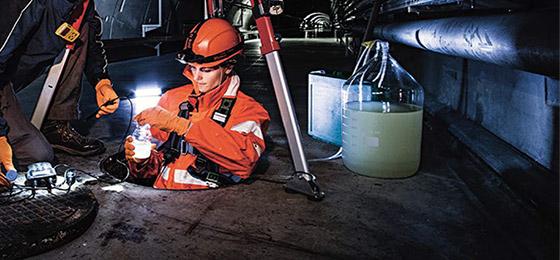In the bowels of the city

The sewers of Zurich provide us with important data about the drug consumption of its citizens. As part of her doctoral thesis, the environmental engineer Ann-Kathrin McCall has been developing a method that uses samples from our sewers to help us assess trends in the use of cocaine and ecstasy. By Christian Weber
(From "Horizons" no. 106, September)
Image: Aldo Torado © Eawag
"No, there are no rats down there. They’d have nowhere to run because the pipes are knee-deep in water, right up to the walls. And yes, it stinks, but you get used to it. Sometimes weird things float past you – like dentures, for example. More often it’s toilet paper and faeces, but I just ignore all that. What matters is that the sewer is an incredibly exciting place! In scientific terms, of course.
“It’s very slippery down there. But nothing’s ever happened to me. I’ve only once landed on my behind. I’m well equipped with waders, a protective suit, a helmet and a facemask, and I’m secured by means of a wire cable that’s fixed above the manhole cover. I also have a small device with me to warn me if carbon monoxide or hydrogen sulphide fumes reach a level where they’re poisonous. What’s really exhausting is that I’m 1.8 metres tall, but the sewers are often less than 1.5 metres from top to bottom. So I have to work bent over most of the time, and my back really hurts after collecting samples for half an hour.
“The basis of my work, to put it crudely, is that every drug-user has to go to the toilet at some point. The residues and metabolic products of their amphetamines, ecstasy and cocaine enter the sewers through their urine. You only have to do a chemical analysis of the wastewater to know what a city is flushing away. Theoretically, everything humans excrete can be measured – even alcohol, caffeine, pregnancy hormones and stress hormones. The sewer offers you a fingerprint of society.
“The problem is that illegal drugs and their metabolites are altered by microorganisms and other chemical and physical processes on their path from the toilet to the sewage treatment plant. My research is about trying to find out exactly what happens. Then we would be able to offer a more reliable interpretation of the samples from the treatment plants. What’s especially important in these transformation processes is the so-called biofilm that grows along the sewer walls, especially where the wastewater flows constantly. The biofilm is about a centimetre thick, very slimy and slippery. It is home to the bacteria, algae, fungi and other microorganisms able to metabolise drugs and other substances.
“I go into the sewers mostly to take samples of this biofilm. Most of my actual work takes place in the laboratory at Eawag, the Swiss Federal Institute of Aquatic Science and Technology. I’ve built a kind of artificial sewer there that I can observe under controlled conditions, and where I can measure what the biofilm does with standardised drug samples.
“All the countries in Europe are interested in assessing trends in drug consumption. In 2014, our international work group presented its first large-scale study. We’d measured the values of five different drugs in the sewers of 42 European cities for one week at a time. The results showed, for example, that Zurich has the third-biggest consumption of cocaine after Antwerp and Amsterdam. What was less surprising was that there’s an ecstasy peak in Zurich at weekends, or that we find rather exotic drugs after the Street Parade. Wastewater analysis has already improved when it comes to assessing trends in drug consumption. Above all, it offers quicker results than anonymous surveys.
“That’s why, when I give a paper at a conference, I often start with a joke. I ask everyone in the audience to put up their hand if they’ve used cocaine. Usually, no one responds. Then I say, "you see, that’s why we need my method"!"